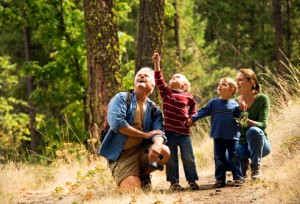 One of the best ways to communicate any message to your children is through regular rituals that are woven into the fabric of your family’s lives. The consistency of intention and action help ingrain the messages you want your children to get most. The use of rituals is very effective in teaching your children about a love of nature and their responsibility for taking care of Mother Earth.
One of the best ways to communicate any message to your children is through regular rituals that are woven into the fabric of your family’s lives. The consistency of intention and action help ingrain the messages you want your children to get most. The use of rituals is very effective in teaching your children about a love of nature and their responsibility for taking care of Mother Earth.
From a very early age, my wife, Sarah, and I created family rituals for our daughters, Catie and Gracie, that taught them about caring for nature and environmental stewardship. For example, they are expected to throw their waste into one of three recycling bins in our kitchen (compost, paper, and plastic) after meals. On Monday evenings, they help me take this recycling from the kitchen and deposit it into the big bins outside which we then roll out to the curb for Tuesday morning pick up. One of our longest-standing rituals involves eating an orange together after dinner. It is my job to peel the orange and it is Catie’s and Gracie’s job to take turns bringing the rind to the compost.
Tanya created two rituals for her son and daughter for picking up trash they come across. Once a month, they walk the length of their street with trash bags and collect the many bottles, cans, and assorted trash that accumulate on the side of the road. She thinks of it as a kind of “adopt-a-highway” without the official imprimatur. Their neighbors often come out to greet and thank them, providing another conduit to reinforce her message of environmental stewardship. She and her children have been big hikers since as soon her kids could walk and Tanya saw a great opportunity to have a spontaneous “adopt-a-trail” experience. While out on a hike, Tanya will see some trash, pick it up, and announce her catchphrase, “I love Earth!” Within a short time, with no explanation or discussion, her children have begun to follow her lead by picking up trash that they see and then declaring “I love Earth!”
Even though her family lives in the suburbs, Nancy is committed to driving as little as possible. Fortunately, they live in a town in which many stores are not far from their home. She makes biking to the grocery store and on other errands a weekly ritual with her son Andy. Andy loves the different ways he gets to go biking with his momma. At first, it was on one of those handlebar seats where he had a front-and-center view. He then progressed to a bike trailer where he was able to read and play with his stuffed animals. From there, he moved to a trailer bike that enabled him to pedal. Andy, at age six, now rides his own bike when they go shopping. Nancy has found this ritual one of those special times that she can really connect and have fun with Andy. Plus, in addition to the environmental message, she’s able to send other positive messages about physical health and enjoying the outdoors.
Mark and Rachel decided to celebrate “Green Day” every week with their three children, the goal of which is to use as little energy as possible. On Saturdays, they walk or bike instead of driving their cars, use candles for light and the fireplace for heat, use only the smallest amount of water, and won’t use any large appliances such as the washer/dryer, stove, or oven (they did keep their fridge plugged in though). Plus, the family chooses an activity that will make the Earth happy, for example, pick up trash in the neighborhood or ride their bikes to town.
This blog post is excerpted from my third parenting book, Your Children are Listening: Nine Messages They Need to Hear from You (The Experiment Publishing, 2011).

